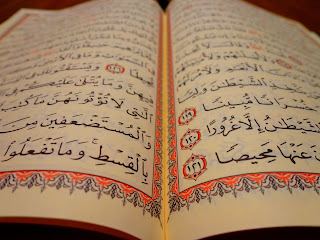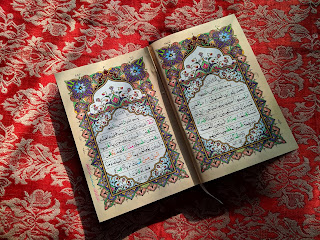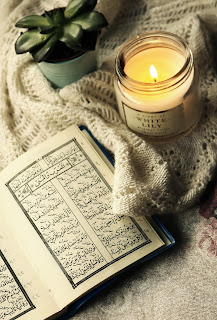There are many functions in Islamic calligraphy art in Islamic culture.
1. Quranic.
2. Poetry.
3. Architectural decoration.
4. Wall decoration
5. Numismatics.
6. Religious and administration documents.
7. Single decoration Album pages.
8. Tughra.
9. Ornamental inscriptions on small objects.
1. Quranic :
Probably the most important function for decorative writing in Islamic culture is that producing copies of the Holy Quran. Not only is the actual text executed in beautiful and legible writing, but many decorative additions are often combined with text.
(a) Rosettes, Medallions, and Roundels :
The earliest ornaments used were rosettes, medallions, and roundels. These occur as marginal decorations to mark the ends of ayahs and Surahs, or to indicate the ajza, the ashirahs, or sajdah.
 |
Roundels in the Quran |
(b) Ornamental Panels :
Another form of Quranic Ornamentations probably originated in the 9th century. This consists of decorative bands and panels. These appear at the opening of the surahs, or perhaps only to introduce specific surahs chosen for more elaborate decoration. The panels usually contain the title and number of the surah to follow, as well as the number of its verses.
 |
Ornamental Panels |
(c) Single Decoration Pages :
In the Quran copies of the 10th century are found the earliest examples of full-page arabesque ate the beginnings and end of the books or chapters. These use a wide variety of motifs for additions, molding, and integration calligraphic designs. Such decorative pages were later to became an expected part of any finely produced manuscript. Beautiful examples of these are displayed in the calligraphy exhibit of the Topkapi Saray Museum in Istanbul.
 |
Single decoration Page |
2. Poetry
Beautiful calligraphy is also found in copies of poetic works. These have not been given the consistent care or the elaborate exercise of writing talent the calligraphers have shown to the Holy Quran. Yet, some beautiful examples can be found, especially in the Iranian and Indian Islamic legacy.
3. Architectural Decoration :
Calligraphy played an im[ratnt role in architectural decoration of every type, in all regions and periods. Passages from the Quran are the most frequent literary material used in these decorations. The designs of beautiful writing may be only pannels, borders, doors, or maybe on the structural elements. They are made up of a variety of materials, used singly or in combination. The most common of these media are bricks, ceramics, craved stucco, carved and painted wood, and stone.
4. Wall Decoration :
The production of calligraphy design for wall decoration has been an art practiced in all Muslim regions and times. In corporating short passages from the Quran, pious saying, the names of God or attributes of God as well as the name of Prophet Muhammad S.A.W.W and the early caliphs have been a favorite subject for such decoration. They are hung on the walls of both domestic and public buildings in the Muslim World. Pieced textiles, paint on paper, embroidery, bamboo, carved ivory, stucco, plaster, shaped metals, ceramics, and even plastics are the popular material for this decoration which are cherished by Muslims everywhere.
5. Numismatics :
Coins have provided instances of decorative calligraphy from the first century of Islam till today. Particularly beautiful examples can be viewed in the books of Miles and People. Some of the coins contain only the necessary information concerning the value and origin of the coin written in a beautiful script. Others include the calligraphic design with the word ''Allah'', a tughra of the ruler issuing the coin, or a pious saying in elaborate script.
6. Religions and Administrative documents:
Given the predilection for beautiful writing, it is not strange that religious and admins documents produced by the Muslims were also executed with great care and decorative skill. The Diwani script is the one most favored for such documents, but titles and headings in thuluth are also common.
7. Single decoration Album Pages :
Around 1500, a fashion the creation of albums containing miniature illustrations, arabesque designs, and calligraphic pages developed in Persia after its introduction from China. It was soon to move to India where the Mughal emperors further developed this use of calligraphy.
8. Tughra :
These are decorative signature seal designs created by calligraphers for wealthy patrons or political leaders. Each one of the carriers the name of its owner written in an elaborate combination of thuluth and Diwani script to form an attractive design. The tughra was used not only as a signature for messages and documents but also as emblems for heading imperial edicts. A typical example is shown in Illustration.
9. Ornamental Inscriptions on Small Art Objects:
No accouterment of a public building or individual residence is considered complete without a suitable calligraphic decoration. Whether for public and private use, ceramics bowls or plates, metal vessels, wooden furniture, glass bowls, or lamps, rugs, textile hangings, and garments.
Thank you. Stay Tuned for more informative blogs.







JazakAllah
ReplyDeleteLoved this article
Very informative
ReplyDeleteLoved your article ♥️ found it so helping
ReplyDeletelove this article mashaAllah
ReplyDeletehttps://www.negiuttarkhandi.com/2020/05/CoronamotivationQuote.html?m=1
ReplyDelete